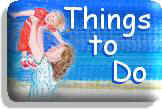|
Back to Table of Contents
Because Jake and the Migration of the Butterfly contains so many natural connections between content areas, it was often difficult to classify an activity into one curricular content area. For example, Butterflies in Your Tummy was placed in the art section, but because it also works with geometric shapes, it could have easily been included in the math section.
The following pages identify some of the National Standards met in the activities contained in this document.
Jake
and the Migration of the Monarch
By
Christina Hunter
|
|
Math
|
Science
|
- Time
- Temperature
- Addition
- Adding
On
- Seasons
- Sequence
- Place
Value
- Distance
- Patterns
- Directional
Words
- Symmetry
- Measurement
|
- Wind
- Clouds
- Flight
- Constellations
- Matter
- Survival
(Camouflage & Needs)
- Living/Nonliving
- Migration
- Weather
(Climate & Mist)
- Weight
- Observation
Skills
- Life
Cycle
|
|
Social
Studies
|
Reading/Language
Arts
|
- Geography
(Carolina Coast, Canada, Mexico)
- United
States
- Compass
Rose
- Map
Skills
- Finding
Direction with the Sun
- Family
- Personal
History
|
- Rhyming
Words
- Questions
- Quotation
Marks
- Responding
to Text (Drama)
- Parts
of Speech (Verbs/Nouns)
- Writing
for Different Purposes
|
National Standards:
Dance
- Identifying and demonstrating movement elements and skills in performing dance.
- Butterfly Dance — nonlocomotor/axial movements, levels, personal
space, straight and curved pathways, kinesthetic awareness, concentration,
focus (found in the Dance/Movement
section of the Curriculum Guide).
-
Freeze Game — Holding shapes, focus
-
Tableau — Focus, concentration, levels
-
Butterfly Role Play — levels, personal space, kinesthetic awareness
-
Symmetry — develop symmetrical dance movements
- Understanding choreographic principles, processes, and structures.
-
Jake’s Song (Orff Version) — Creating a dance in the interlude sections, realize form, improvise
-
Finger Play — Mirror, copy, lead, follow. Sequential patterns
-
Butterfly Dance — form, sequence, create, perform, demonstrate the ability to work together
-
Tableau — create, perform, demonstrate the ability to work together
-
Continuing Jake’s Song — form, rhythm, sequence
- Understanding dance as a way to create and communicate meaning.
-
Jake’s Song (Orff Version) — present dances to peers and discuss meanings
-
Butterfly Dance — Interpretations and reactions, presenting a dance to peers
- Applying and demonstrating critical and creative thinking skills in dance.
-
Butterfly Dance — Multiple solutions to a given problem
- Demonstrating and understanding dance in various cultures and historical periods.
- Making connections between dance and healthful living.
- Making connections between dance and other disciplines.
National Standards: Drama
- Script writing by planning and recording improvisations based on personal experience and heritage, imagination, literature, and history.
- Who are You? – Improvise dialogue to tell stories (found in the Drama section of the Curriculum Guide)
- Butterfly Role Play – Improvise dialogue to tell stories (Drama)
- Tableau – Collaborate to select interrelated characters (Drama)
- Acting by assuming roles and interacting in improvisations.
- Freeze Game – Use variations of locomotor and non-locomotor movement (Drama)
- Butterfly Dance – Use variations of locomotor and
non-locomotor movement (Dance/Movement)
- Tableau – Assume roles that exhibit concentration and contribute to the action of classroom dramatizations (Drama)
- Who are You? – Imagine and clearly describe characters (Drama)
- Butterfly Role Play – Use variations of locomotor and
non-locomotor movement (Drama)
- Designing by visualizing and arranging environments for
classroom dramatizations.
- Tableau –Visualize environments and construct designs to communicate locale and mood using visual elements and aural aspects using a variety of sound sources (Drama)
- Butterfly Role Play -- Visualize environments and construct designs to communicate locale and mood using visual elements and aural aspects using a variety of sound sources (Drama)
- Directing by planning classroom dramatizations.
- Tableau – Collaboratively plan and prepare improvisations and demonstrate various ways of staging classroom dramatization (Drama)
- Butterfly Role Play -- Collaboratively plan and prepare improvisations and demonstrate various ways of staging classroom dramatization (Drama)
- Researching by finding information to support classroom dramatizations.
- Who are You? – Communicate to peers about people, events, time, and place related to classroom dramatizations (Drama)
- Comparing and connecting art forms by describing theatre, dramatic
media (such as film, television, and electronic media), and other art
forms.
- Analyzing and explaining personal preferences and constructing meanings from classroom dramatizations and from theatre, film, television, and electronic media productions.
- Who are You? – Explain how the wants and needs of characters are similar and different from their own (Drama)
- Understanding context by recognizing the role of theatre, film, television, and electronic media in daily life.
- Who are You? – Identify and compare similar characters and situations in stories and drama (Drama)
National Standards: English/Language Arts
Note: The reading of Jake and the Migration of the Monarch
addresses many of the goals below. With that assumption, only the activities in the resource documents are listed below.
- Reading for Perspective
- Who are You? (Found in the Drama section of this document)
- Understanding the Human Experience
- Freeze Game (Drama)
- Tableau (Drama)
- Evaluation Strategies
- Tableau (Drama)
- Butterfly Poetry (English/Language Arts)
- Communication Skills
- Developing Rhythm Through Poetry (Music)
- Freeze Game (Drama)
- Tableau (Drama)
- Butterfly Poetry (English/Language Arts)
- Communication Strategies
- Developing Rhythm Through Poetry (Music)
- Tableau (Drama)
- Who are You? (Drama)
- Butterfly Role Play (Drama)
- Butterfly Poetry (English/Language Arts)
- Applying Knowledge
- Developing Rhythm Through Poetry (Music)
- Tableau (Drama)
- Continuing Jake’s Song (Music)
- Butterfly Poetry (English/Language Arts)
- Evaluating Data
- Continuing Jake’s Song (Music)
- Developing Research Skills
- Multicultural Understanding
- Butterfly Poetry (English/Language Arts)
- Applying Non-English Perspectives
- Finger Play (Dance/Movement)
- Freeze Game (Drama)
- Tableau (Drama)
- Participating in Society
- Applying Language Skills
- Developing Rhythm Through Poetry (Music)
- Tableau (Drama)
- Butterfly Role Play (Drama)
- Continuing Jake’s Song (Music)
- Butterfly Poetry (English/Language Arts)
National Standards: Math
- Number and Operations
- Counting/Census – Understand numbers, ways of representing numbers (found in the Math section of the Curriculum Guide)
- Butterfly Census – Compute fluently and make reasonable estimates (Math)
- Algebra
- Developing Rhythm Through Poetry – Understand patterns, relations, and functions (Music)
- Jake’s Song for Orff Instruments – Understand patterns, relations, and functions (Music)
- Geometry
- Butterfly Feet – Apply transformations and use symmetry to analyze mathematical situations (Visual Arts)
- Learning Symmetry by Designing a Butterfly – Apply transformations and use symmetry to analyze mathematical situations (Visual Arts)
- Butterflies in Your Tummy – Analyze characteristics and properties of two-and three-dimensional shapes (Visual Arts)
- Measurement
- Butterfly Game – Apply appropriate techniques, tools, and formulas to determine measurements by graphing the map (Social Studies)
- Data Analysis and Probability
- Butterfly Census -- Formulate questions that can be addressed with data and collect, organize, and display relevant data to answer (Math)
- Butterfly Game – Probability of butterfly survival through developing and evaluating inferences and predictions (Social Studies)
- Problem Solving
- K-W-H-L Chart – Organize and consolidate thinking through communication (Science)
- Reasoning and Proof
- Butterfly Census – Communicate mathematical thinking coherently and clearly to peers, teachers, and others
- Communication
- Connections
- Jake’s Song for Orff Instruments
- Developing Rhythm Through Poetry
- Butterfly Feet
- Learning Symmetry by Designing a Butterfly
- Representation
National Standards: Music
- Singing, alone and with others, a varied repertoire of music.
- a. Jake’s Song – Sing expressively, with appropriate dynamics, phrasing, and interpretation (found in the Music section of the Curriculum Guide)
- Developing Rhythm through Poetry – Ostinatos, rounds (Music)
- Performing on instruments, alone and with others, a varied repertoire of music.
- Jake’s Song Composed for Orff Instruments – Perform independent instrumental parts while other students sing or play contrasting parts (Music)
- A Musical Story – Perform expressively (Music)
- Improvising melodies, variations, and accompaniments.
- Developing Rhythm Through Poetry – Improvise “answers” in the same style to given rhythmic and melodic phrases (Music)
- Jake’s Song Composed for Orff Instruments – Improvise short songs and instrumental pieces (Music)
- A Musical Story – Improvise short songs and instrumental pieces using a variety of sound sources (Music)
- Composing and arranging music within specified guidelines.
- Continuing Jake’s Song – Create and arrange short songs and instrumental pieces within specific guidelines (Music)
- A Musical Story – Use a variety of sound sources when composing (Music)
- Reading and notating music.
- Jake’s Song – Identify symbols and traditional terms referring to dynamics, tempo, and articulation and interpret them correctly when performing (Music)
- Listening to, analyzing, and describing music
- Recorded music in different versions – Jake’s Song, Jake’s Song for Orff Instruments, Butterfly music performed on the piano (all on this web site)
- Butterfly Dance – Identify simple music forms when presented aurally (Dance)
- Evaluating music and music performances
- Recorded music in different versions – Jake’s Song, Jake’s Song for Orff Instruments, Butterfly music performed on the piano (all on this web site)
- Any of the class performances of the compositions associated with this book.
- Understanding relationships between music, the other arts, and disciplines outside the arts.
- Developing Rhythm Through Poetry
- Jake’s Song in Spanish
- Recommended Music with a Butterfly Theme
- Many of the activities in this document use common terms – relating those to students ensures relevance. For example, dance and music will both use form, canon, levels, etc.
- Understanding music in relation to history and culture.
- With any classroom performance from materials in this document, students will demonstrate audience behavior appropriate for the context and style of the music performed.
National Standards: Science
- Science as Inquiry
- K-W-H-L Chart – Abilities necessary to do scientific inquiry (found in the Science section of this document)
- Butterfly Flip Book – Understanding about scientific inquiry (Science)
- Growing Butterflies – Understanding about scientific inquiry (Science)
- Physical Science
- Monarch Migration Game – Game pieces that demonstrate properties of objects and materials (Science)
- Butterflies in Your Tummy – Properties of objects and materials (Science)
- Life Science
- K-W-H-L Chart – Organisms and environments (Science)
- Butterfly Life Cycle – Life cycles of organisms (Science)
- Butterfly Plate – Organisms and environments (Science)
- Butterfly Flip Book – Life cycles of organisms (Science)
- Growing Butterflies – The characteristics of organisms (Science)
- Monarch Migration Game – The characteristics of organisms (Social Studies)
- Butterfly Tag – The characteristics of organisms (Dance/Movement)
- Butterfly Role Play – The characteristics of organisms (Drama)
- Who are You? – The characteristics of organisms (Drama)
- Butterflies in Your Tummy – The characteristics of organisms (Visual Arts)
- Earth and Space Science
- Growing Butterflies – Properties of earth materials (Science)
- Monarch Migration Game – Properties of earth materials (Science)
- Science and Technology
- Personal and Social Perspectives
- Growing Butterflies – Characteristics and changes in populations, Science in local challenges (Science)
- Monarch Migration Game – Characteristics and changes in populations (Science)
- Butterfly Role Play – Characteristics and changes in populations (Science)
- History of Nature and Science
- All activities address science as a human endeavor
National Standards:
Social Studies
- Civics
- Getting Started – How is the world divided into nations? (Social Studies Section)
- Economics
- Geography
- Getting Started – Understand how to use maps (Social Studies section)
- Monarch Migration Game – Understand how to use mental maps (Social Studies)
- U.S. History
- Many of these activities support the understanding of family life
- World History
National Standards:
Visual Arts
- Understanding and applying media, techniques, and processes.
- Butterflies in your Tummy – Use different media, techniques, and processes to communicate ideas, experiences, and stories (found in the Visual Arts section of the Curriculum Guide)
- Butterfly Feet -- Use different media, techniques, and processes to communicate ideas, experiences, and stories (found in the Visual Arts section of the Curriculum Guide)
- Learning Symmetry by Designing a Butterfly-- Use different media, techniques, and processes to communicate ideas, experiences, and stories (found in the Visual Arts section of the Curriculum Guide)
- Butterfly Plate (Science)
- Butterfly Flip Book (Science)
- Using knowledge of structures and functions.
- All of the visual arts activities develop the knowledge of the differences among visual characteristics and purposes of art to convey meaning.
- Choosing and evaluating a range of subject matter, symbols, and ideas.
- All of the visual arts activities promote the selection and use of subject matter, symbols, and ideas to communicate meaning.
- Understanding the visual arts in relation to history and cultures.
- Butterfly Plate – Understand that there are different purposes for creating works of art (Science)
- Reflecting upon and assessing the characteristics and merits of their work and the work of others.
- Butterflies in Your Tummy – Understand that there are various purposes for creating works of art (Visual Arts)
- Making connections between visual arts and other disciplines.
- All of the visual art activities in this document support content in life science
- All of the visual art activities use the common language in geometry (shapes) and other arts (symmetry, form).
|




